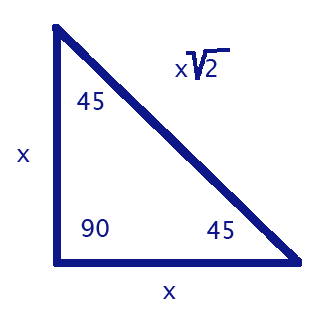First off, there is the 45-45-90 triangle. As the name suggests, it contains one right angle, and two 45 degree angles.
 This is fairly basic. The two legs, (the two sides that are touching the 90 degree angle) are both 'x' because they are congruent. The hypotenuse is simply x square-roots of 2. If the length of each leg was, lets say 5, x would equal 5. The hypotenuse would then be square roots of 2. Really, for a problem like this, you don't even need to do the work. You just need to know that if the problem gives you the length of a leg, then the hypotenuse is that number, times the square-root of 2.
This is fairly basic. The two legs, (the two sides that are touching the 90 degree angle) are both 'x' because they are congruent. The hypotenuse is simply x square-roots of 2. If the length of each leg was, lets say 5, x would equal 5. The hypotenuse would then be square roots of 2. Really, for a problem like this, you don't even need to do the work. You just need to know that if the problem gives you the length of a leg, then the hypotenuse is that number, times the square-root of 2.Another way they will give you this problem is they will give you the hypotenuse and you have to solve for the legs.
Here, what we would do, is set up an equation. This might end up looking weird for there is no character for the radical.
1.25=x (square root 2)
We do this because as shown in the first diagram, the hypotenuse is equal to x times the square root of 2. Now we want to get 'x' by itself. So we divide both sides by the square root of 2.
1.25 = x
square root 2
The general rule of thumb when dealing with radicals (square root signs), is that the cannot be in the denominator, or the bottom of the fraction. To get rid of it, we are going to multiply both the top of the fraction and the bottom by the square root of 2.
1.25 * square root of 2 = x
2
Square root of 2 times the square root of 2 is 2. If the first numerator, in this case 1.25 was even, then you could simplify further, but for this problem, we aren't going to have to.
As always, if you have any questions, comment!
No comments:
Post a Comment